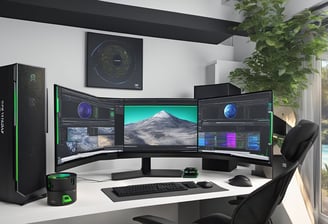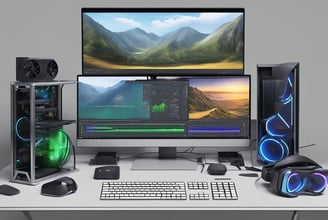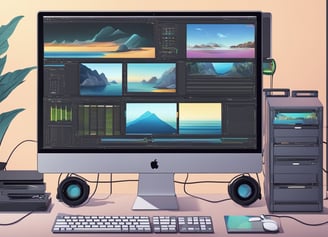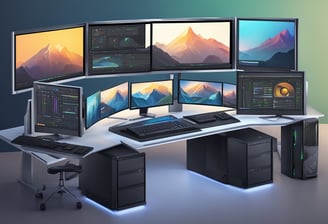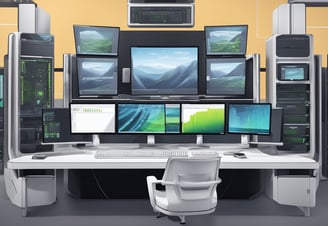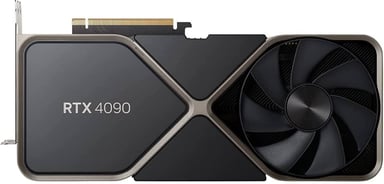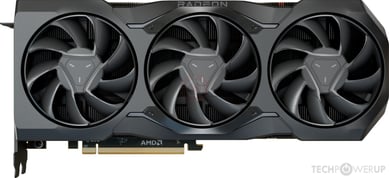RTX 4090 vs RX 7900 XTX: Which is better for Video Editing & Rendering in 2025
4/5/2025
As video editing and rendering demands continue to rise, selecting the right graphics card is crucial for professionals and enthusiasts alike. In 2025, the competition between Nvidia's RTX 4090 and AMD's RX 7900 XTX is particularly fierce, as both offer impressive performance tailored to high-end creative work. For those focused on video editing and rendering, the Nvidia RTX 4090 often emerges as the superior choice due to its advanced architecture and powerful features.
The RTX 4090's capabilities in real-time ray tracing and AI-powered editing tools provide an edge for users requiring precision and speed. In contrast, the RX 7900 XTX remains competitive in raw performance and price, catering well to those who prioritize budget without a significant compromise on quality. Ultimately, the decision hinges on specific workflows and individual preferences, but understanding the strengths of each card is essential.
As creators explore their options, comparing the technological advancements and practical benefits of these GPUs can illuminate the best fit for their projects. This blog post will examine the features, performance metrics, and user experiences to provide a well-rounded analysis of these leading graphics cards.
Comparison of Specs
Overview of Nvidia RTX 4090 and AMD RX 7900 XTX
The Nvidia RTX 4090 is part of the Ada Lovelace architecture. It is designed for high-performance tasks, including video editing and rendering. This model features advanced ray tracing capabilities and AI-powered technologies, enhancing workflow efficiency.
The AMD RX 7900 XTX utilizes the RDNA 3 architecture. It focuses on providing competitive performance at a more affordable price point. The card shines in tasks requiring high frame rates and can manage demanding applications well.
Performance Highlights
RTX 4090: Excels in ray tracing and AI tasks.
RX 7900 XTX: Offers great performance in traditional rasterization.
Both cards serve specific needs in video editing and rendering but cater to different budgets and use cases. Their architectures lead to unique advantages that are impactful in practical applications.
Performance Comparison for Video Editing
The Nvidia RTX 4090 and AMD RX 7900 XTX are both powerful graphics cards for video editing. Their performance can vary based on the specific software used and the tasks involved.
Key Specifications
Nvidia’s CUDA cores provide enhanced support for many video editing applications. This can lead to faster rendering times and smoother playback in programs like Adobe Premiere Pro and DaVinci Resolve.
The RX 7900 XTX, while lacking dedicated ray tracing cores, still performs well in traditional video editing tasks. Its large VRAM allows it to handle high-resolution projects effectively.
Performance Benchmarks
Rendering Speed: The RTX 4090 shows a consistent performance boost in rendering complex projects.
Playback Performance: Both cards manage 4K playback well, but the RTX 4090 might excel under heavy effects and multiple edits.
Overall Experience
The RTX 4090 tends to offer a more stable experience with heavy workflows. In contrast, the RX 7900 XTX is a good choice for users focused on budget without sacrificing too much performance in standard editing tasks.
In different scenarios, the choice may depend on specific software optimization and budget considerations.
Rendering Capabilities and Benchmarks
When comparing the rendering capabilities of the Nvidia RTX 4090 and AMD RX 7900 XTX in 2025, both graphics cards show impressive performance metrics.
Key Specifications:
For video editing software that leverages CUDA, the RTX 4090 delivers superior performance. It excels in rendering timelines and processing effects due to its higher CUDA core count.
On the other hand, the RX 7900 XTX uses its AMD architecture effectively. It performs well in applications optimized for OpenCL and offers competitive rendering speeds.
Benchmark Results:
In benchmark tests, the RTX 4090 generally outperforms the RX 7900 XTX in high-resolution tasks.
4K Rendering: RTX 4090 - 95 FPS, RX 7900 XTX - 82 FPS
1080p Rendering: RTX 4090 - 160 FPS, RX 7900 XTX - 140 FPS
For tasks that require extensive shader calculations, the RTX 4090 maintains a distinct edge. This advantage makes it a preferred choice for professional video editors seeking top-tier performance.
The RX 7900 XTX remains a strong contender for users focused on cost-efficiency while still requiring solid rendering performance.
Graphic Architecture and Technologies
The architectural differences between the Nvidia RTX 4090 and AMD RX 7900 XTX have significant implications for video editing and rendering. Their specialized technologies cater to different workflows, impacting both performance and productivity.
Ray Tracing Performance
Nvidia's RTX 4090 leverages its advanced Ada Lovelace architecture to provide superior ray tracing performance. It uses dedicated RT cores that enhance real-time ray tracing capabilities. This results in more accurate light and shadow rendering, making it ideal for projects requiring realistic visuals.
In contrast, the AMD RX 7900 XTX utilizes a different approach with its RDNA 3 architecture. While it offers ray tracing support, the performance may lag behind the RTX 4090 in highly demanding scenarios. Benchmarks show that the RTX 4090 consistently outperforms the RX 7900 XTX in ray-traced applications, making it the better choice for professionals emphasizing visual fidelity.
AI Acceleration and DLSS vs. FSR
Nvidia's RTX 4090 features advanced AI acceleration through its Tensor cores, enabling technologies like DLSS (Deep Learning Super Sampling). DLSS enhances frame rates without sacrificing image quality by using AI algorithms to upscale lower-resolution images during rendering.
The AMD RX 7900 XTX includes FidelityFX Super Resolution (FSR), a competing technology aimed at improving performance. While FSR has made significant progress, it typically does not achieve the same level of quality as DLSS. Many users find that DLSS delivers a more refined result, particularly in scenarios involving real-time rendering and high-resolution output, making it advantageous for video editing tasks.
Price-to-Value Assessment
When comparing the Nvidia RTX 4090 and AMD RX 7900 XTX for video editing and rendering, it's essential to evaluate their initial purchase cost and long-term value. These aspects directly impact the overall investment for professionals in the field.
Initial Purchase Cost
The Nvidia RTX 4090 typically has a higher initial purchase price, often exceeding $1,600. This premium is attributed to its advanced architecture and superior performance in demanding tasks.
In contrast, the AMD RX 7900 XTX usually retails for around $1,000 to $1,200. While more affordable, potential buyers should consider the performance trade-offs in rendering and editing capabilities.
Price sensitivity plays a crucial role. Many professionals might favor the RX 7900 XTX due to its lower entry cost, especially if they're operating within a budget.
Long-Term Value
Long-term value encompasses performance longevity, software optimization, and future-proofing capabilities. The Nvidia RTX 4090 generally excels in performance due to its CUDA cores, making it an attractive choice for software that leverages GPU acceleration.
Conversely, the AMD RX 7900 XTX delivers robust performance but may not match the longevity of the RTX 4090 in highly demanding applications.
Additionally, software developments often prioritize Nvidia's architecture, potentially enhancing the value for users who frequently update their tools.
In this context, professionals should weigh their immediate budget against future software needs and rendering demands.
Conclusion and Recommendations
When choosing between the Nvidia RTX 4090 and AMD RX 7900 XTX for video editing and rendering in 2025, key factors include performance, software compatibility, and budget.
Performance:
Nvidia RTX 4090: Superior performance in applications that leverage CUDA cores. Excellent for real-time rendering and effects.
AMD RX 7900 XTX: Competitive performance, particularly with apps optimized for its architecture. Good for users who focus on raw power at a lower cost.
Software Compatibility:
Nvidia: Well-supported in industry-standard software like Adobe Premiere Pro and DaVinci Resolve.
AMD: Gaining ground with updated drivers and software support but may lag in some specific applications.
Recommendations:
For Professionals:
Choose the Nvidia RTX 4090 if budget allows. It excels in high-demand environments.
For Enthusiasts:
The AMD RX 7900 XTX provides excellent value and can handle most tasks effectively.
Budget Considerations:
The RX 7900 XTX presents a cost-effective alternative for users who need solid performance without the premium price tag.
Making a decision should consider specific use cases and desired performance metrics. Both GPUs have unique strengths suited for different types of workflows.
Other Related Blogs
Best NVIDIA Graphics Cards for Video Editing in 2025
Discover the top-performing NVIDIA GPUs for video editors using tools like Adobe Premiere Pro, DaVinci Resolve, and Final Cut Pro. This guide compares specs, pricing, and real-world editing performance to help you choose the right card for your workflow.
Best GPUS for 3d Rendering in Blender and Cinema 4d (2025 Guide)
A detailed breakdown of the best GPUs for 3D artists and animators working in Blender, Cinema 4D, and similar software. Learn which cards deliver the fastest rendering speeds, best value, and smoothest viewport performance.
NVIDIA RTX 4090 (see available prices)
AMD RX 7900 XTX (see available prices)

